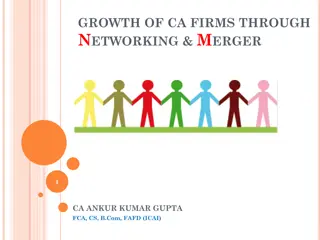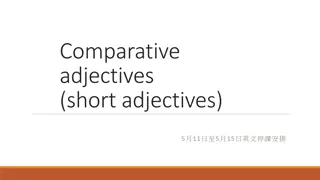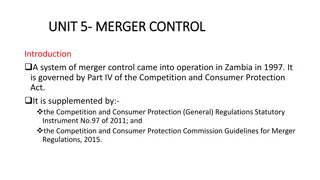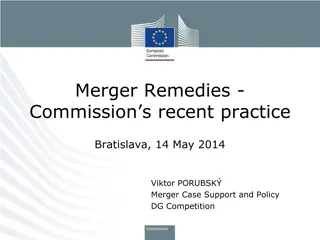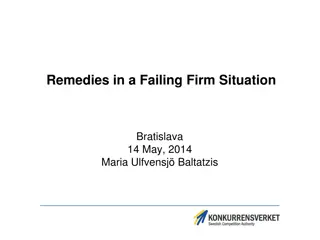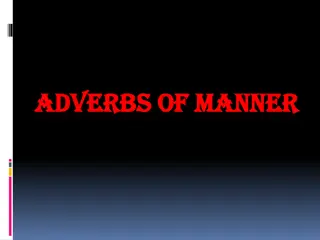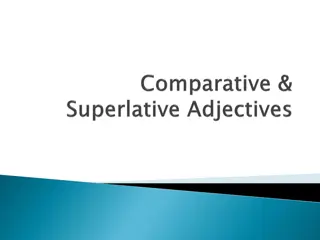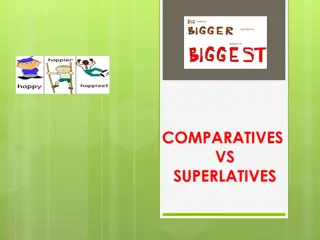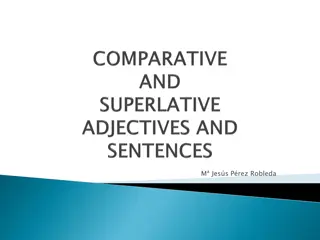Cultural Integration Analysis: Top Adjectives for Ideal Company Culture Post-Merger & Acquisition
Utilizing text analysis, three key adjectives were identified to define the integrated culture of organizations post-merger and acquisition. The top adjectives include innovative, collaborative, and customer-centric. Insights from the comparison between Organization 1 and Organization 2 highlight a blend of values such as teamwork, transparency, and respect, while also emphasizing market competitiveness with varying adjectives.
Download Presentation

Please find below an Image/Link to download the presentation.
The content on the website is provided AS IS for your information and personal use only. It may not be sold, licensed, or shared on other websites without obtaining consent from the author.If you encounter any issues during the download, it is possible that the publisher has removed the file from their server.
You are allowed to download the files provided on this website for personal or commercial use, subject to the condition that they are used lawfully. All files are the property of their respective owners.
The content on the website is provided AS IS for your information and personal use only. It may not be sold, licensed, or shared on other websites without obtaining consent from the author.
E N D
Presentation Transcript
Merger & Acquisition Text Analysis Share 3 adjectives that you feel should describe the culture of our integrated company between Organization 1 and Organization 2. Research & Development
Overview Top adjectives defining an ideal integrated culture Cross Comparisons Adjectives for culture frequently used together Appendix
Top adjectives defining an ideal integrated culture
Top 10 Combined, Org 1, and Org 2 Combined ADJECTIVES INNOVATIVE COLLABORATIVE CUSTOMER-CENTRIC* TEAM-WORK AMBITIOUS TRANSPARENT COOPERATIVE AGILE RESPECT SHARING FREQUENCY 232 179 85 76 68 59 45 41 40 39 *Other variants of customer-centric include oriented , -driven , -focused , satisfaction
Cross Comparisons Insights from this section are derived from charts shown in the Appendix.
Key Insights Org 1 respondents showed a stronger focus on a culture that is respectful, inclusive, and diverse Respectful was used 3.6 times more often by Org 1 respondents ( Inclusive 1.37 times more; Diversity 1.48 times more) - Org 1 respondents showed a prioritization of clarity and communication Clarity was used 8 times more often by Org 1 respondents ( Clear 1.38 times more; Communication 1.35 times more) - Org 1 respondents highlighted a prioritization of team-work & sharing Team-work was used 1.61 times more and Sharing was used 1.9 times more by Org 1 respondents - Org 2 respondents showed a stronger focus on openness & transparency Open was used 2 times more by Org 2 respondents and Transparency was used 1.58 times more - Both organizations showed a prioritization of market competitiveness, but respondents used distinct adjectives to describe that culture Org 1 respondents used Global , Growth , Competitive , and Ambitious more often - Org 2 respondents used Strong , Driven , Fast , Exciting , Agile , and Flexible more often -
Adjectives for culture frequently used together Adjectives in green are those that are not in the Top 10 but were listed most frequently with Top 10 adjective those in white are other Top 10 adjectives.
Innovative & Collaborative Innovative Collaborative ADJECTIVES COLLABORATIVE FREQUENCY 37 ADJECTIVES INNOVATIVE FREQUENCY 37 CUSTOMER-CENTRIC* 15 TRANSPARENT 16 DYNAMIC 13 CUSTOMER-CENTRIC* 12 AMBITIOUS 11 RESPECT 9 TRANSPARENT 11 AMBITIOUS 7 AGILE 9 INCLUSIVE 7 INCLUSIVE 8 TEAM-WORK 7 REWARDING 7 SHARING 6 COMPETITIVE 6 CLEAR 5 CHALLENGE 5 FLEXIBLE 5 Respondents who mentioned a culture of innovation also mentioned a dynamic, inclusive, rewarding, competitive, and challenging culture. Respondents who mentioned a collaborative culture also mentioned inclusion, clarity, and flexibility. *Other variants of customer-centric include oriented , -driven , -focused , satisfaction. In these tables, FREQUENCY refers to the number of times a given word was listed alongside the Top 10 adjective in the title.
Customer-Centric & Team-Work Respondents who described a customer- centric culture also mentioned a culture that is fast, bold, friendly, creative, and driven. Respondents who described a culture of team- work also mentioned communication and encouragement as well as a culture of motivation, recognition, and rewarding. *Other variants of customer-centric include oriented , -driven , -focused , satisfaction. In these tables, FREQUENCY refers to the number of times a given word was listed alongside the Top 10 adjective in the title.
Ambitious & Respect Respondents who described an ambitious culture also mentioned a culture that is caring, dynamic, efficient, flexible, multicultural, and competitive in the market. Respondents who described a culture of respect also mentioned multiculturalism and inclusivity. *Other variants of customer-centric include oriented , -driven , -focused , satisfaction. In these tables, FREQUENCY refers to the number of times a given word was listed alongside the Top 10 adjective in the title.
Transparent & Cooperative Respondents who described a transparent culture also mentioned communication, trust, a desire for challenge, as well as a culture that is dynamic, efficient, flexible, and inclusive. Respondents who described a cooperative culture also mentioned openness, unity, caring, and competitiveness in the market. In these tables, FREQUENCY refers to the number of times a given word was listed alongside the Top 10 adjective in the title.
Agile & Sharing Respondents who described a culture of sharing also mentioned a focus on clear communication and a culture that is marked by supporting, challenging, clarity, and encouragement. Respondents who described an agile culture also mentioned culture that is flexible, fast, dynamic, driven, efficient, and encouraging. *Other variants of customer-centric include oriented , -driven , -focused , satisfaction. In these tables, FREQUENCY refers to the number of times a given word was listed alongside the Top 10 adjective in the title.
Innovative ** Cross-Comparisons use a standard measure of Rate per 10,000 words , which allows us to compare data across groups in the data while controlling for differences in the size of those groups.
Collaborative ** Cross-Comparisons use a standard measure of Rate per 10,000 words , which allows us to compare data across groups in the data while controlling for differences in the size of those groups.
Customer-Centric ** Cross-Comparisons use a standard measure of Rate per 10,000 words , which allows us to compare data across groups in the data while controlling for differences in the size of those groups.
Team-Work ** Cross-Comparisons use a standard measure of Rate per 10,000 words , which allows us to compare data across groups in the data while controlling for differences in the size of those groups.
Ambitious ** Cross-Comparisons use a standard measure of Rate per 10,000 words , which allows us to compare data across groups in the data while controlling for differences in the size of those groups.
Transparent ** Cross-Comparisons use a standard measure of Rate per 10,000 words , which allows us to compare data across groups in the data while controlling for differences in the size of those groups.
Cooperative ** Cross-Comparisons use a standard measure of Rate per 10,000 words , which allows us to compare data across groups in the data while controlling for differences in the size of those groups.
Agile ** Cross-Comparisons use a standard measure of Rate per 10,000 words , which allows us to compare data across groups in the data while controlling for differences in the size of those groups.
Respect ** Cross-Comparisons use a standard measure of Rate per 10,000 words , which allows us to compare data across groups in the data while controlling for differences in the size of those groups.
Sharing ** Cross-Comparisons use a standard measure of Rate per 10,000 words , which allows us to compare data across groups in the data while controlling for differences in the size of those groups.






